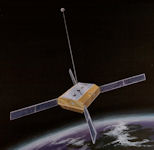Parcae / White Cloud - Electronic Intelligence Satellite
 During a Centennial Exhibition, held at the Pentagon on 28 September 2023, to commemorate the U.S. Naval Research Laboratory's (NRL) 100 years of operations, the National Reconnaissance Office (NRO) declassified an NRL-developed electronic intelligence satellite program called Parcae (pronounced "p?rsee", less commnly "parkay"). Launched from 1976 to 1996, under mission numbers 7108 and 7120, Parcae and Improved Parcae were Low Earth Orbit electronic intelligence collection systems that downlinked the collected data to ground processing facilities located at selected locations around the world. Once received, the data was provided to the National Security Agency for processing and reporting to U.S. policymakers.
During a Centennial Exhibition, held at the Pentagon on 28 September 2023, to commemorate the U.S. Naval Research Laboratory's (NRL) 100 years of operations, the National Reconnaissance Office (NRO) declassified an NRL-developed electronic intelligence satellite program called Parcae (pronounced "p?rsee", less commnly "parkay"). Launched from 1976 to 1996, under mission numbers 7108 and 7120, Parcae and Improved Parcae were Low Earth Orbit electronic intelligence collection systems that downlinked the collected data to ground processing facilities located at selected locations around the world. Once received, the data was provided to the National Security Agency for processing and reporting to U.S. policymakers.
The ancient Greeks believed that many aspects of a person’s life were determined by the three mythical women known as Fates. These were three sister goddesses that appeared in Greek and Roman mythology and were believed to have “spun out” a child’s destiny at birth. They determined when life began, when it ended, and everything in between. At the birth of each man they appeared spinning, measuring, and cutting the thread of life. Known as Moirai or Moerae in Greek Mythology and Fata or Parcae by the Romans, their names in Greek were Clotho, (“the spinner”), Lachesis (“the apportioner”) and Atropos (“the inevitable”).
Homer wrote in the Iliad, “it was the will of fate that the Greeks destroy Troy, when Rumor and Panic caused the Greeks to want to flee. Aeneas was fated to go to Italy, despite the best efforts of Hera. Hera's actions in attempting to defy fate led to a premature death of Dido, the queen of Carthage. Since her thread was not cut to so short a length, she would not die even though a dagger had pierced her breast.”
The Parcae of mythology were the three fates, and the Parcae spacecraft famously consisted of a triplet of spacecraft flying in formation to provide triangulated location of radio sources. "With 100 years of history, the Naval Research Lab has been advancing science in national security well before we could actually leverage space," said Dr. Troy Meink, principal deputy director of the NRO. "Today's Centennial offers an opportunity to talk about how the lab's many innovations have helped the National Reconnaissance Office use the vantage point of space to keep America safe and stronger."
After the success of the GRAB and Poppy signals collection programs, and with increasing concerns about the Soviet Navy, NRL, as part of the NRO's Program C, developed the next system that would collect the needed information on the Soviet Union's naval fleet. The system, Parcae, was the programmatic follow-on to GRAB and Poppy. Later on, the NRO developed the next generation of Parcae, referred to as Improved Parcae, which added the capability to collect against and recognize selected foreign communication systems.
"What we are celebrating today, is not simply the journey of the Navy's premiere research laboratory or its contributions to the naval service, instead we are celebrating a journey of American ingenuity and a legacy of our best scientists," said Under Secretary of the Navy the Honorable Erik K. Raven and presiding host. "Our ability to deal with national security and economic threats of today rests heavily on the work of the scientists, engineers and support staff at the Naval Research Laboratory."
 For the first time, a model of Parcae was on display during the exhibition. The NRL workforce showcased their past, present, and future research and highlighted the enduring relationship with government partners and the need for continued investment in scientific research. "With our eyes fixed on the future, NRL's first century must inspire resilience in us as serious threats remain," said Dr. Bruce Danly, NRL director of research. "The NRL ventures now into its next century with the same strong commitment to a vital mission that cannot rest."
For the first time, a model of Parcae was on display during the exhibition. The NRL workforce showcased their past, present, and future research and highlighted the enduring relationship with government partners and the need for continued investment in scientific research. "With our eyes fixed on the future, NRL's first century must inspire resilience in us as serious threats remain," said Dr. Bruce Danly, NRL director of research. "The NRL ventures now into its next century with the same strong commitment to a vital mission that cannot rest."
Since opening its gates in 1923, NRL has changed warfighter technologies, advanced military capabilities, surpassed contemporary scientific understanding, and transferred vital innovations to industry. "We are indeed in an innovative race and it is one that we must win - innovation must always permeate every aspect of our Department's approach to the delivery of technologies and capabilities at the speed and scale necessary for our Navy and Marine Corps to be successful," said Secretary of the Navy the Honorable Carlos Del Toro. "I encourage all of you, our nation's scientists, engineers, researcher, inventors, entrepreneurs and problem solvers to join us."
To determine the location of radio-emitting objects by means of a passive location, the triangulation method, the hyperbolic method and their combinations implemented in multi-position systems are used. The triangulation (goniometer) method is little dependent on the types and size of the frequency spectrum of the received radio signals. The main advantage of this method is the high energy of its receiving channels, since two or more high-potential radio direction finders with sufficiently large gain antennas are used to measure the angular coordinates of the target, which together with the adaptive receiving device provide high real sensitivity.
The hyperbolic (differential-ranging) method of determining the location of the target is used in a multi-position system consisting of 3 receiving nodes. In this case, one of the reception points serves as the central reception point. The specificity of this method is such that, in contrast to the triangulation method, this method requires the fulfillment of the “cooperative reception” condition, i.e. reception of the same signal emitted by the source of radio emission by all nodes. The resulting total energy potential is quite sufficient for determining, by the chronometric method, sufficiently accurate differences in the received signals of radiation sources such as short range radio navigation interrogators, identification transponders, etc., using simple short-pulse signals with steep fronts and operating at fixed frequencies.
As a well-known combination of the combined use of the goniometric (triangulation) and difference-rangefinder (hyperbolic) methods, the so-called goniometric-difference-rangefinder or goniometric-hyperbolic method is considered. The essence of the method is the detection and direction finding of the emitter using at least two passive stations spaced in space from the central (reference) and calculating the coordinates of these sources of radio emission in three stages. At the first stage, at each node, search and detection of the emitter is carried out, the time-frequency parameters of their signals are measured, at the second stage, at least two RRLs continuously monitor the selected emitter and record the reception time of each pulse of this emitter, at the third stage, by measured bearings and times reception of each pulse followed by emitter ultimately determine its azimuth and location coordinates.
NRO/USN/NSA, SIGINT NOSS EORSAT Spacecraft
By © Charles P. Vick 2007 All Rights Reserved
PARCAE - White Cloud – SIGINT NOSS EORSAT Spacecraft Series – (NRO/USN/NSA Program AFP-MSD-180)
Code name PARCAE – “White Cloud” was the first in a long series of earth orbit NRO/USN/NSA, SIGINT (signals intelligence) interferometry spacecraft used by the USN. They were launched by the Atlas-E, F, H and Titan-II series of booster with a total of at least nine launches using the Atlas series and three launches using the Titan-II series. The spacecraft were actually nothing more than US Navy’s services specific sophisticated earth orbit space based earth receiving stations operating over the entire emitted electro magnetic radio spectrum frequency range. The PARCAE were flow in packages of three spacecraft not including their bus dispenser with an FW-4S apogee kick motor stage and up to four satellites on the Titan-2 launches and their bus stage. Its bus dispenser stage used a Thiokol Star-37E solid motor. The total mass of the Atlas series packages was up to 2,999 pounds while the Titan-II packages mass was up to 4,410 pounds. PARCAE first launch was apparently April 30, 1976, and its last launch was apparently May 15, 1987 on the Atlas series while its first Titan-II launch was September 5, 1988 and its last launch was April 22 1992 They were designed to monitor and pick up from the ocean through both SIGINT and interfermetric radio emissions analysis to locate ships and the direction and rate of traversing the ocean for strategic observations.
Initially the Titan-II PARCAE series had been thought to be a part of a new SBR-WASS SINGLETON Radar satellite series that was ultimately cancelled in the conceptual development phase by NRO. That program was ultimately replaced by the continuation of the PARCAE series four satellite plus bus dispenser stage program.
The technology for these SIGINT, interferometric PARCAE spacecraft series had evolved from the GRAB and DYNO series initially developed by the US Navy.
Each spin stabilized spacecraft package was about 108 inches long with the primary spacecraft only 40 inches long. The Atlas package has a maximum diameter of less than 72 inches. Each spacecraft had a life of three to five years while the bus package has a life of only about a month. PARCAE’s spacecraft were designed with both multiple feed horn receiving external face designs as well as surface solar arrays. The launch shroud for the Atlas series was 198 inches long with an external diameter of 84 inches while it’s inside diameter was 75-79 inches . The Titan-II launch shroud was 10 feet in diameter and 25 feet long not including the launch vehicle adapter.
The Atlas launched PARCAE spacecraft series were operated at an inclination that was at approximately 63 degrees with a perigee between 655.82 miles and an apogee of 723.78 miles with a spacecraft life of three to five years. The Titan-II series were operated at an approximate inclination of 85 degrees with a circular orbit of about 800 kilometers with at least one of the four satellites left in a separate orbit. The precise formation constellation of three spacecraft was able to receive and send the data to several global ground and ship board stations via radio signal operated by NSA/USN personnel. The data was then processed and analyzed as received for naval operations.
References:
1. McDowell, Jonathan , U. S. Reconnaissance Satellites Programs, Part 2: Beyond Imaging, Quest, Vol. 4, No. 4.
2. Dr Day, Dwayne A., Robotic Ravens, Spaceflight, Vol. 47, No. 11, Nov. 2005, pp. 426-433.
The U.S. Navy's "White Cloud" Spaceborne ELINT System, Andronov and Obozreniye (trans. Allen Thomson), Foreign Military Review, No.7, 1993.
|
NEWSLETTER
|
| Join the GlobalSecurity.org mailing list |
|
|
|



